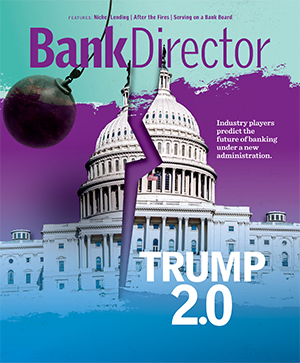As CEO of Airiam, Kuk has over 20 years of experience helping organizations strategically implement new technologies and innovations. empowering small and regional banks to harness cutting-edge technology. With a deep history in cyber security and automation, Kuk and his team believe in democratizing enterprise-grade AI, cyber, and business resilience solutions for SMBs. Prior to Airiam, he founded the corporate venture capital and corporate development teams at Best Buy and was deeply involved in the development of the company’s credit and financial services offerings. In addition to Board roles at multiple venture-backed companies, Kuk has also held senior finance, technology, and investment roles at PwC, Samsung, and Transformco.

Implementing an AI Framework for Banks
When utilized strategically, artificial intelligence can be a powerful tool for smaller banks to meaningfully deliver measurable benefits.
Brought to you by Airiam

The financial services landscape is evolving at an unprecedented pace, making artificial intelligence (AI) adoption increasingly essential for financial institutions, including community banks.
With industry consolidation accelerating and customer expectations rising, it is particularly important for regional and smaller banks to assess how AI can strengthen their competitive position.
The breadth and scope of AI across an organization — from customer service to cash operations — makes it difficult to determine where and how to start the AI journey. And given its strategic importance, bank executives today are faced with making investment decisions in AI to ensure growth and competitiveness.
In this rapidly evolving environment, it can be tempting to initiate a comprehensive AI-driven transformation.
However, leaders should instead look to invest in specific high-impact applications that deliver measurable benefits, rather than expand systematically. For example, many community banks begin with back-office automation while planning for eventual customer-facing implementations as capabilities mature, as BusinessWorld’s implementation research demonstrates.
The following is a helpful framework for bank leaders looking to strategically implement AI solutions in their organizations, including:
1. Starting with specific, high-impact use cases. Focus on areas where AI can deliver immediate value, such as loan processing, customer service automation or fraud detection.
2. Considering partnerships. Many successful implementations involve partnerships with fintech companies that have already developed and tested AI solutions, reducing development costs and implementation risks.
3. Retaining platform flexibility. Ensure the core AI strategy or platform avoids dependence on a specific technology or vendor — AI is still changing and evolving rapidly.
4. Building on existing platforms. Look for AI solutions that can integrate with your existing core systems rather than requiring complete replacements.
5. Measuring concrete benefits. Set clear metrics for success, such as increased conversion rates, reduced processing times or cost savings.
6. Focusing on customer experience. Prioritize AI implementations that directly improve the customer experience, such as faster loan approvals or 24/7 digital assistance.
AI can be a powerful tool for smaller banks to meaningfully deliver measurable business benefits without the large technology budgets that larger institutions have access to. By focusing on specific use cases with clear return on investment (ROI) and leveraging partnerships where appropriate, even the smallest banks can compete effectively in today’s increasingly digital banking landscape.
Some examples of quick-win AI implementations are outlined below to provide bank executives a view of how to get started quickly in AI with strong ROI.
Some examples of these quick-win AI implementations include:
- First National Bank of Omaha implemented an AI-powered personal loan platform where the AI-backed lending approach approved “27 percent more borrowers than traditional lending models with 16 percent lower average APRs for approved loans.” The system received validation from the Consumer Financial Protection Bureau in the form of a No-Action Letter, demonstrating regulatory acceptance of the AI approach.
- Veridian Credit Union implemented AI-driven fraud detection platforms which have helped Veridian “achieve a minimal loss rate of 15%” while handling “an average of over 1,770 chargebacks each month.” The implementation improved investigations and boosted member satisfaction while reducing call volume.
- Idaho Central Credit Union implemented an automated accounting system that delivered significant productivity improvements. The credit union “freed up 80-100 hours of time every month, automated 75% of expense reports, and reduced data entry time 50%.” This example shows how AI and automation technologies can transform back-office functions that are critical but often overlooked for innovation, creating efficiencies that free staff for higher-value work.
- MidFlorida Credit Union deployed custom AI credit models for auto and personal loans which “safely approves more members overlooked by legacy scoring, achieving 25% to 30% higher approvals with no added risk.” This implementation demonstrates how community financial institutions can leverage AI to expand lending to underserved populations while maintaining appropriate risk controls, creating both business growth and community benefit.
As noted in these examples, AI represents both a technological advancement and strategic necessity for navigating an increasingly competitive landscape. While implementation challenges are substantial, the potential benefits justify strategic investment.
Forward-thinking executives understand that the power of AI is in augmenting rather than replacing human capabilities. By handling routine transactions and queries, AI enables staff to concentrate on relationship-building and complex customer needs where personal judgment provides greatest value and competitive differentiation.
With the right partnerships and approach, executives at community banks can leverage AI to strengthen their unique market position and fulfill their essential role within the communities they serve.


